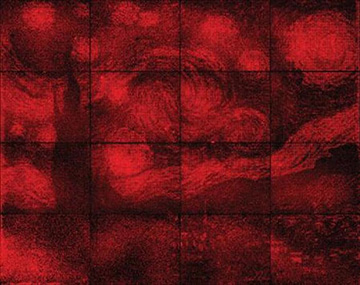
The Caltech group used DNA origami to precisely position fluorescent nanoparticles within a grid of 65,536 resonant photonic crystal cavities—to create a monochrome replica of Van Gogh’s famous painting The Starry Night. The grid is described as being “the width of a [U.S.] dime across.” [Image: Ashwin Gopinath/Caltech] [Enlarge image]
A research team led by Paul Rothemund of the California Institute of Technology (Caltech), USA, has shown how the emerging technique of “DNA origami” can be used to precisely position and couple molecular emitters, such as fluorescent molecules, within tiny, resonant photonic crystal cavities, or PCCs (Nature, doi: 10.1038/nature18287). And the team did the demonstration in style, using the technique to create a 65,536-pixel monochrome rendering of Van Gogh’s famous The Starry Night, on a canvas of PCCs less than 2 cm wide.
Rothemund summarizes the approach as “like using DNA origami to screw molecular light bulbs into microscopic lamps.” In the view of the team, it offers a potentially scalable, bottom-up approach to fabricating hybrid nanophotonic devices that must combine chemically diverse, nanoparticle-based emitters with optical resonators in precise locations.
Precise nanoparticle delivery
DNA origami, pioneered in Rothemund’s lab ten years ago, involves creating precisely folded bits of DNA that then serve as scaffolds that chemically attach to specific nanoscale components—for instance, proteins, gold nanospheres, or fluorescent molecules. (Showing a gift for analogy, Rothemund has described the system as “a general-purpose pegboard for organizing nanometer-sized things.”)
In work published in 2009, Rothemund, along with scientists at IBM Research, showed that electron-beam lithography could be used to create complementary-shaped binding sites that grab onto bits of similarly shaped DNA origami. That, in turn, opened up the possibility to use the folded DNA bits as a delivery system for precisely positioning their attached nanoparticles onto surfaces in actual devices.
A dime-sized Starry Night
To show how this technique might be used to create hybrid nanophotonics, the researchers began by chemically fashioning, from a bacteriophage genome, triangular-shaped bits of DNA origami with an affinity for binding to a red-glowing cyanine dye fluorophore, Cy5. Next, they etched a 256×256 checkerboard pattern of photonic crystal cavities, tuned to resonate at a red wavelength of around 660 nm, on a 275-nm-thick silicon-nitride layer about the width of a U.S. dime across. They used electron-beam patterning to place chemical binding sites for between zero and seven of the fluorophore-charged DNA origami pieces at precise positions in each of the 65,536 PCCs.
The specific location, and number, of binding sites within each PCC on this template was determined by analysis of a simplified, 256×256-pixel grayscale version of Van Gough’s The Starry Night. Varying the number and position of binding sites for the fluorophore-carrying DNA origami pieces at each pixel provided a sort of digital control switch that could be used to tweak the intensity of illumination emanating from each of the 65,536 resonant PCC “lamps.” The result was a digital, dime-size, monochrome replica of the famous painting.
Rapid prototyping for hybrid nanophotonics
Caltech senior postdoctoral scholar Ashwin Gopinath, the paper’s lead author, notes that the approach overcomes a previous problem in scalably coupling nanoscale light emitters to PCCs: the “extraordinary difficulty of reproducibly controlling the number and position of emitters in a cavity.” As a result, the study concludes, the method could be “well suited for the rapid prototyping of a broad array of hybrid nanophotonic devices.”
